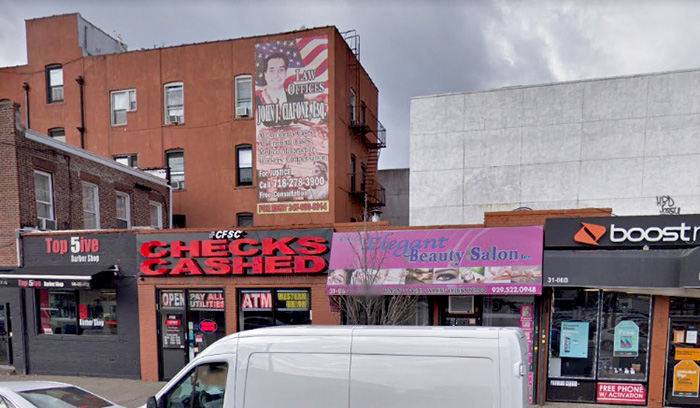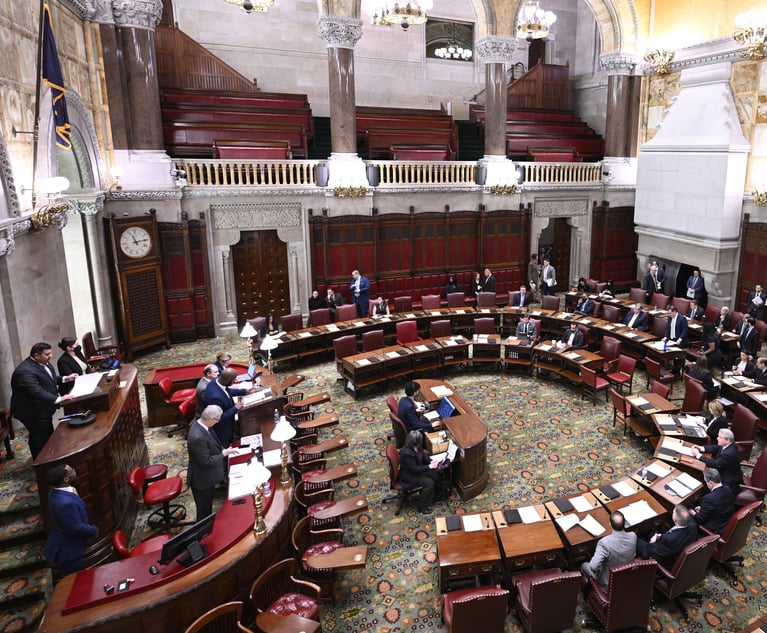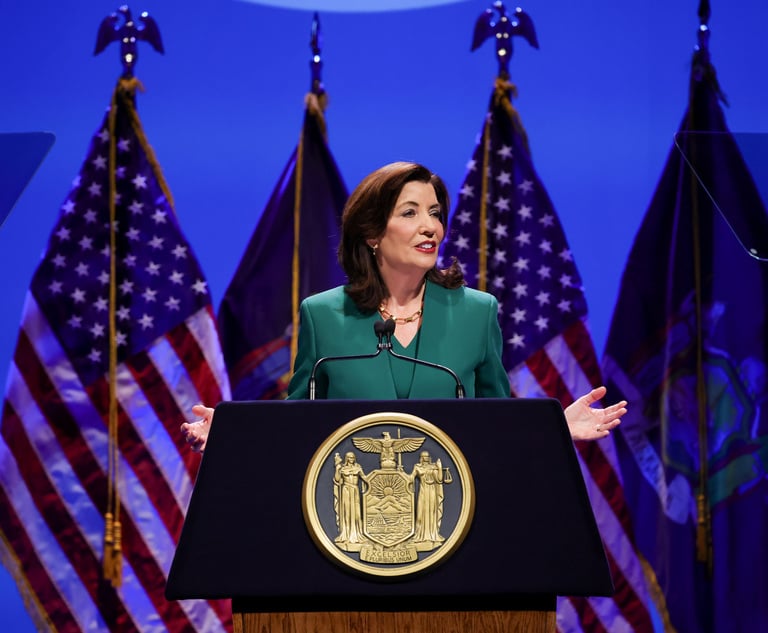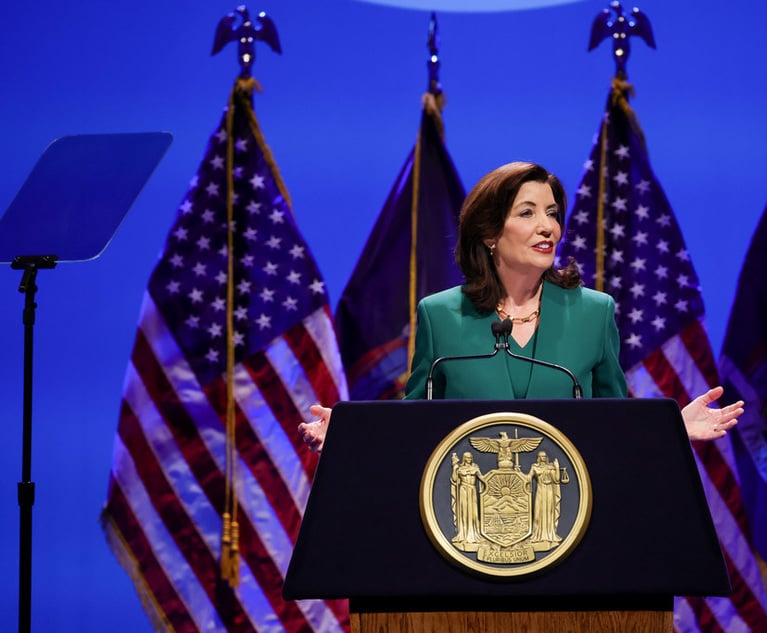NY High Court Upholds $380K Fine Over Attorney's Ads on Corporate-Owned Buildings
Signs advertising Ciafone's law practice, the Law Offices of John J. Ciafone Esq., were posted on five buildings in Brooklyn and Queens without a permit from the city.
December 17, 2019 at 12:54 PM
6 minute read
 An ad for Law Offices of John J. Ciafone Esq.
An ad for Law Offices of John J. Ciafone Esq.
The New York Court of Appeals on Tuesday upheld a $380,000 fine that was indirectly levied against a Queens-based attorney, whose law firm was improperly advertised on five buildings he owned through a set of corporate entities.
The state high court ruled that the fine was lawfully imposed by an agency in New York City against corporations owned by John Ciafone, despite his indirect ownership of the buildings.
Associate Judge Rowan Wilson of the New York Court of Appeals wrote, for a unanimous court, that Ciafone couldn't avoid a city law that required a permit for advertising his law firm on the buildings, even if he owned the corporations, which in turn owned the properties.
"Petitioner corporations, although admittedly owned either by Mr. Ciafone or by both Mr. Ciafone and his spouse, are indisputably distinct legal entities from John J. Ciafone and John J. Ciafone, P.C," Wilson wrote.
The New York City Law Department said in a statement it was pleased with the decision.
"The common good is served when the city is able to implement and enforce its common sense laws governing outdoor advertising. Not every neighborhood should be considered a home for ads best seen in Times Square," the department said. "These laws protect the quality of life. "
Ciafone, in a phone interview with the New York Law Journal, criticized the city's policies that led to the fines.
"As a small business owner in the city of New York, I'm offended by the outrageous conduct of this city to collect and essentially destroy small businesses with their outrageous fines," Ciafone said.
"Why are you holding me to the level of an outdoor advertisement in Times Square? I'm not the same kind of entity, or person," he continued.
At issue in the case was whether the corporations owned by Ciafone should be considered so-called "outdoor advertising companies," which are defined in New York City's laws as entities that make space available to others for purposes of marketing.
The law requires outdoor advertising companies to obtain permits from the city before posting signs that appear to promote the services of another entity.
That didn't happen in this case. Signs advertising Ciafone's law practice, the Law Offices of John J. Ciafone Esq., were posted on five buildings in Brooklyn and Queens without a permit from the city.
Each of those five buildings are owned by four corporations. Those four corporations are owned by either Ciafone or his wife, according to his attorneys.
The New York City environmental control board fined the corporate entities $380,000 over the signs because, as they argued, Ciafone isn't the actual owner of the buildings. The properties are owned by Ciafone's corporations, not Ciafone himself, the city argued.
The Court of Appeals, on Tuesday, agreed with the city. Wilson wrote that, because the corporations had made space available for advertising—even though the signs were marketing their owner—they were considered outdoor advertising companies.
"Thus, by advertising a distinct legal entity on their buildings, petitioner corporations made space available to others and are OACs under the Code," Wilson wrote.
Ciafone wasn't a party to the lawsuit. The challenge was brought against the city, instead, by the set of corporate entities he purports to own. They were represented before the Court of Appeals by Lindsay Garroway, a partner at Cohen, Hochman & Allen in Manhattan.
Garroway had argued before the Court of Appeals in November that New York City lawmakers would have never enacted a law intended to fine small business owners like Ciafone hundreds of thousands of dollars for advertising his firm on buildings he indirectly owned.
In a statement Tuesday, Garroway made the same point and urged the New York City Council to amend the law that was used to fine her clients.
"We respect the Court's decision, but we disagree with its interpretation of the law passed by the City Council," Garroway said. "There is no way the City Council intended this result when it passed the law, and we urge City Council to reconsider and reframe the law to protect small business owners like my client."
Outside the legal trapeze of the case, Ciafone is the owner of the buildings, she had argued, albeit through the corporate entities. That should allow the corporations to escape the fines, she argued.
That was the case in a different matter involving a business owner named Joseph Nativo. He was able to avoid the city's fines because he showed he was advertising his own business on a building he owned. Nativo owned the building directly, rather than through a corporation.
The Court of Appeals, on Tuesday, ruled that Ciafone's case wasn't the same as what happened with Nativo.
At the end of the day, Wilson wrote, Ciafone wasn't the direct owner of the buildings on which his law firm was advertised. There's no getting around that, he wrote.
"Because Mr. Ciafone, his professional corporation and petitioner corporations are separate legal entities, petitioner corporations are OACs under the plain language of Administrative Code § 28-502.1," Wilson wrote.
It was Ciafone's choice to own the buildings through a set of corporate entities, rather than directly in his own name, Wilson wrote. That choice comes with some advantages, like tax and liability benefits. It also comes with different standards, he said.
"The New York City Council could rationally conclude that a corporation engaged in the provision of advertising to others, even others who have an ownership interest in the corporation, should be subjected to greater financial disincentives for violating signage laws than natural persons who are advertising themselves," Wilson wrote.
The case was an appeal from the Appellate Division, First Department, which had also ruled that the fines couldn't be avoided by showing Ciafone owned the buildings through corporate entities. They upheld the penalty in a 3-2 vote.
The two dissenting justices, in that decision, had called it "logically absurd" for city officials to leave the fines in place.
READ MORE:
Court of Appeals Weighs $380K Fine Over Attorney Ads on Corporate-Owned Buildings
Corporate Ownership of Building Put Lawyer Ad Signs in Violation of Billboard Law: Court
This content has been archived. It is available through our partners, LexisNexis® and Bloomberg Law.
To view this content, please continue to their sites.
Not a Lexis Subscriber?
Subscribe Now
Not a Bloomberg Law Subscriber?
Subscribe Now
NOT FOR REPRINT
© 2025 ALM Global, LLC, All Rights Reserved. Request academic re-use from www.copyright.com. All other uses, submit a request to [email protected]. For more information visit Asset & Logo Licensing.
You Might Like
View All
Relaxing Penalties on Discovery Noncompliance Allows Criminal Cases to Get Decided on Merit
5 minute read
Bipartisan Lawmakers to Hochul Urge Greater Student Loan Forgiveness for Public-Interest Lawyers

'Playing the Clock'?: Hochul Says NY's Discovery Loophole Is to Blame for Wide Dismissal of Criminal Cases

So Who Won? Congestion Pricing Ruling Leaves Both Sides Claiming Victory, Attorneys Seeking Clarification
4 minute readTrending Stories
- 15th Circuit Considers Challenge to Louisiana's Ten Commandments Law
- 2Crocs Accused of Padding Revenue With Channel-Stuffing HEYDUDE Shoes
- 3E-discovery Practitioners Are Racing to Adapt to Social Media’s Evolving Landscape
- 4The Law Firm Disrupted: For Office Policies, Big Law Has Its Ear to the Market, Not to Trump
- 5FTC Finalizes Child Online Privacy Rule Updates, But Ferguson Eyes Further Changes
Who Got The Work
J. Brugh Lower of Gibbons has entered an appearance for industrial equipment supplier Devco Corporation in a pending trademark infringement lawsuit. The suit, accusing the defendant of selling knock-off Graco products, was filed Dec. 18 in New Jersey District Court by Rivkin Radler on behalf of Graco Inc. and Graco Minnesota. The case, assigned to U.S. District Judge Zahid N. Quraishi, is 3:24-cv-11294, Graco Inc. et al v. Devco Corporation.
Who Got The Work
Rebecca Maller-Stein and Kent A. Yalowitz of Arnold & Porter Kaye Scholer have entered their appearances for Hanaco Venture Capital and its executives, Lior Prosor and David Frankel, in a pending securities lawsuit. The action, filed on Dec. 24 in New York Southern District Court by Zell, Aron & Co. on behalf of Goldeneye Advisors, accuses the defendants of negligently and fraudulently managing the plaintiff's $1 million investment. The case, assigned to U.S. District Judge Vernon S. Broderick, is 1:24-cv-09918, Goldeneye Advisors, LLC v. Hanaco Venture Capital, Ltd. et al.
Who Got The Work
Attorneys from A&O Shearman has stepped in as defense counsel for Toronto-Dominion Bank and other defendants in a pending securities class action. The suit, filed Dec. 11 in New York Southern District Court by Bleichmar Fonti & Auld, accuses the defendants of concealing the bank's 'pervasive' deficiencies in regards to its compliance with the Bank Secrecy Act and the quality of its anti-money laundering controls. The case, assigned to U.S. District Judge Arun Subramanian, is 1:24-cv-09445, Gonzalez v. The Toronto-Dominion Bank et al.
Who Got The Work
Crown Castle International, a Pennsylvania company providing shared communications infrastructure, has turned to Luke D. Wolf of Gordon Rees Scully Mansukhani to fend off a pending breach-of-contract lawsuit. The court action, filed Nov. 25 in Michigan Eastern District Court by Hooper Hathaway PC on behalf of The Town Residences LLC, accuses Crown Castle of failing to transfer approximately $30,000 in utility payments from T-Mobile in breach of a roof-top lease and assignment agreement. The case, assigned to U.S. District Judge Susan K. Declercq, is 2:24-cv-13131, The Town Residences LLC v. T-Mobile US, Inc. et al.
Who Got The Work
Wilfred P. Coronato and Daniel M. Schwartz of McCarter & English have stepped in as defense counsel to Electrolux Home Products Inc. in a pending product liability lawsuit. The court action, filed Nov. 26 in New York Eastern District Court by Poulos Lopiccolo PC and Nagel Rice LLP on behalf of David Stern, alleges that the defendant's refrigerators’ drawers and shelving repeatedly break and fall apart within months after purchase. The case, assigned to U.S. District Judge Joan M. Azrack, is 2:24-cv-08204, Stern v. Electrolux Home Products, Inc.
Featured Firms
Law Offices of Gary Martin Hays & Associates, P.C.
(470) 294-1674
Law Offices of Mark E. Salomone
(857) 444-6468
Smith & Hassler
(713) 739-1250






